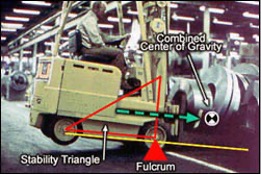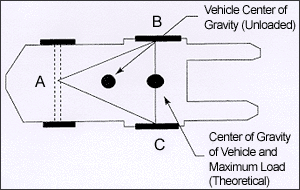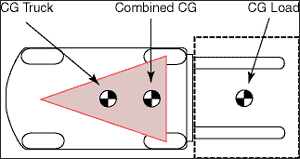Understanding Forklift Load Balance & Stability for Safe Operation

Operating a forklift requires not only an understanding of the controls to drive the forklift and the possible hazards of the workplace surroundings. Operators also need to understand the importance of load stability. Too often operators are not provided sufficient training regarding loads and the dangers presented with operating a forklift beyond its load capacity.
Forklift Load Stability Terms and Definitions
- Center of gravity – The point on an object at which all the object’s weight is concentrated. For symmetrical loads, the center of gravity is at the middle of the load.
- Fulcrum – The forklift’s axis of rotation when it tips over.
- Lateral stability – A truck’s resistance to overturning sideways.
- Line of Action – An imaginary vertical line through an object’s center of gravity.
- Load center – The horizontal distance from the load’s edge to the line of action through the load’s center of gravity.
- Longitudinal stability – The truck’s resistance to overturning forward or rearward.
- Moment – The product of the object’s weight times the distance from a fixed point (usually the fulcrum). With forklifts, the distance is measured from the point at which the truck will tip over to the object’s line of action. The distance is always measured perpendicular to the line of action. Load Moment = Weight x Distance
OSHA addresses load stability in Appendix A of the Powered Industrial Trucks Standard 29 CFR 1910.178. The stated capacity of a forklift only applies to the load center indicated on the data plate. If the load is not centered at the specified position, the forklift’s capacity will be reduced. Loads come in all shapes and sizes, not just symmetrical boxes. The load size, position, and weight distribution critically affect the forklift’s capacity and the stability of the truck.
Determining a forklift’s safe load capacity
The load weight, weight distribution, size, shape, and position are key factors affecting the capacity and the stability of the forklift. Forklifts are designed to carry a capacity load at a standard load center, commonly 24 inches. The forklift’s capacity is determined as if the load were a cube whose weight is evenly distributed, and which is resting on a standard pallet having dimensions of 48 inches by 48 inches. With such a load, the horizontal distance from the center of the load to the vertical part of the forks would be 24 inches. But most loads are not perfectly shaped cubes having their center of gravity exactly in the middle of the cube. Capacity may be reduced with irregularly shaped loads, unbalanced weight distribution, or if the load is not centered on the forks.
Understanding forklift capacity by load weight and load center distance
How weight is distributed changes the amount of weight the forklift can safely carry. This can be seen in the following experiment. An object that weights approximately 5lbs is lifted. This is the same as the forklift lifting an object.
The object is extended straight out away from the body. As it is, the center of the object’s weight moves farther from the body causing the object to feel heavier and causing a fall forward.
The same principle – increasing the load center distance – can cause a forklift to tip over. When the load center distance increases, it is increasing something called the load moment.

Whether an object is stable depends on the object’s moment at one end of a system being greater than, equal to, or smaller than the object’s moment at the system’s other end. This principle can be seen in the way a teeter-totter works. If the product of the load and distance from the fulcrum (moment) is equal to the moment at the device’s other end, the device is balanced, and it will not move. However, if there is a greater moment at one end of the device, the device will try to move downward at the end with the greater moment.
Since the overturning force depends on both the weight of the load and the load’s distance from the pivot point, a forklift’s capacity is always stated in terms of both: the load’s weight and its load center distance. Minimizing the load center distance, measured from the back of the forks to the center of the load, allows the forklift to carry more weight.
How to prevent forklift tipovers and instability
It is important to understand why forklifts tipover and loads become unstable and fall. Two factors that affect a forklift’s balance are the center of gravity and shifting center of gravity.
Center of gravity
Distribute weight evenly when carrying irregular loads and keep the center of gravity of the load as near as possible to the center going horizontally across the forks. Keeping the center of gravity of the load as near the front wheels as possible will reduce the risk of goods and equipment being damaged.

Shifting center of gravity
When the load is placed on the forklift, the combined center of gravity of the forklift and the load will move forward, but the forklift will not tipover so long as the weight of the load is centered and does not exceed the capacity stated on the data plate. But if the load is too heavy, or if it is placed at the end of the forks so that the load center distance is increased, the excessive load moment will cause the forklift to tip forward. Remember, when the forklift engages a load, the combined center of gravity of both the load and the truck system shifts forward from the center of gravity of the unloaded forklift.
Explanation of the forklift stability triangle
Almost all counterbalanced powered industrial trucks have a three-point suspension system meaning the forklift is supported at three points. This is true even if the forklift has four wheels. The truck’s steer axle is attached to the truck by a pivot pin in the axle’s center. When this point is connected to the front wheels with imaginary lines, this three-point support forms a triangle called the stability triangle.

Take a look at this diagram. In the center of the truck is Triangle ABC, where Point A is the pivot point in the rear axle and Points B and C are the front wheels. Remember that the center of gravity on the forklift will change depending on the load or momentum. If the center of gravity ends up outside the triangle, the forklift will tipover.
Let’s look at the center of gravity. An unloaded forklift’s center of gravity is between the axle of the steer wheels at A and the drive wheels at B-C. When the forklift is unloaded, the location of the center of gravity is the only factor for determining stability.
When the forklift is in motion without a load, the center of gravity is near the rear of the vehicle and very close to the side of the stability triangle, so a quick turn or unstable driving surface could cause the forklift to tip over. Be careful!

Here we see that a shift of the center of gravity occurs as the forklift is loaded. The combined center of gravity of the forklift and its maximum load shifts toward the load, so that it is now located on the line representing the front axle at the edge of the stability triangle. While the loaded forklift is theoretically still stable, in practice the combined center of gravity shouldn’t reach this line because sudden stops, starts, and turns could shift the center of gravity further out and destabilize the forklift.
When a forklift is loaded properly, it becomes more stable. However, improper loading, such as loading the forklift beyond its capacity, or loading an oversize or wide load without adjusting the weight, will cause the forklift to tipover. The direction of the tipover will depend on where the combined center of gravity shifts outside the stability triangle.
The combined center of gravity of the forklift and its maximum load shifts forward toward the load so that it is now located on the line representing the front axle, at the very edge of the stability triangle. While the loaded forklift is still theoretically stable, in practice the combined center of gravity should never reach this line because sudden stops, starts, and turns could shift the center of gravity further out and destabilize the truck, creating a forklift safety hazard to the operator and area workers..
Through the forklift’s center of gravity is a vertical line of stability or line of action. If the line of action shifts outside the stability triangle, the forklift will tip over. The placement of the load on the forks, how high the load is raised, the angle of the floor underneath the forklift, and momentum are all factors in keeping the line of action within the stability triangle.
Safe Practices for Forklift Loading and Balance
- Never exceed the stated capacity shown on the forklift’s data plate. If the load is oversized, irregularly shaped, or loaded incorrectly, the actual load center distance could exceed the stated load center distance, causing the truck’s capacity to be exceeded.
- Position the load as close to the front wheels as possible to minimize the load center distance and load the heaviest part toward the mast.
- Use extra caution and drive slower when handling extra heavy loads that may approach the truck’s maximum capacity. When handling a maximum load, the load should be carried at the lowest position possible, the truck should be accelerated slowly and evenly, and the forks should be tilted forward cautiously.
- If your forklift begins to tip, do not jump. You could be crushed beneath the forklift or load. Brace yourself, hold onto the steering wheel and pull yourself tight up to it. Keep all parts of your body inside the operator area.
Providing your workers with a solid understanding of the forklift stability triangle and best practices for load balance can help keep them save from accidents and tipovers. It is crucial for load balance to be understood and practiced while training or refreshing your operators. Training your employees on forklift safety and operation takes careful planning for your in-classroom and on-the-job training. If you’re planning a course on forklift safety, NSC makes it easy.
For our Forklift Safety Training Kits on DVD, USB, or Digital Access visit: https://www.osha-safety-training.net/product-category/topic/subject-forklift-safety/
For our Forklift Safety Training via online LMS visit: https://www.onlineoshatraining.net/product/forklift-safety-training-general-industry/
4 thoughts on “Understanding Forklift Load Balance & Stability for Safe Operation”
You must be logged in to post a comment.

[…] The load weight, weight distribution, size, shape, and position are key factors affecting the capacity and the stability of the forklift. Forklifts are designed to carry a capacity load at a standard load center, commonly 24 inches. via […]
[…] The load weight, weight distribution, size, shape, and position are key factors affecting the capacity and the stability of the forklift. Forklifts are designed to carry a capacity load at a standard load center, commonly 24 inches. via […]
[…] While the loaded forklift is theoretically still stable, in practice the combined center of gravity shouldn't reach this line because sudden stops, starts, and turns could shift the center of gravity further out and destabilize the forklift. When a forklift is loaded properly, it becomes more stable. via […]
[…] Overloading a lifted truck can lead to serious accidents due to an imbalance in weight distribution. It is important to follow the weight limits specified by the vehicle manufacturer and adhere to loading guidelines. Here’s what you should keep in mind: […]